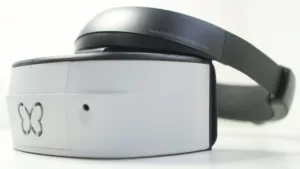A variety of negative physiological effects have found to be been associated with the use of virtual reality headsets. To combat these effects, Lemnis Technologies (Singapore) has developed and has just made available a new technology described as a hardware and software platform called Verifocal.
A demonstration of the technology was presented at SIGGRAPH 2018 recently held in Vancouver. The demo was based on a Microsoft Windows Mixed Reality VR headset. The headset used in the demo is pictured in the figure below.
The Lemnis Technologies VR headset technology was demonstrated at SIGGRAPH 2018.
Head mounted displays typically produce a 3D image by showing different images to the user’s left and right eyes. A problem arises, however, because a conventional 3D headset does not have the ability to induce the user’s eyes to refocus on objects located at different depths within the field of view. This inability is due to the fact that conventional headsets utilize static optics and produce a fixed focal plane. The disconnect between the distance to which the user’s eyes are directed and the distance to which the user’s eyes are focused is called a vergence – accommodation conflict. When the conflict occurs, the result can be physical discomfort including headaches, nausea and eye strain. As a separate issue, efforts to minimize the vergence – accommodation conflict can also put constraints on the content that creators can present on the headset.
Lemnis Technologies states that it has “developed a platform that works together with the human eye to create a natural response that we hope will help more people feel comfortable in virtual reality.”
The Verifocal system uses eye tracking to determine the user’s gaze direction and to identify the depth to which the user is looking. The system then automatically and dynamically adjusts the optimal focus by adjusting the optics of the headset. That is, the varifocal system generates a variable focal plane that adapts in real time. This approach is claimed to minimize vergence – accommodation conflicts and increase user comfort.
Another benefit claimed for Verifocal technology is that it can take into account the user’s eyeglasses prescription. By this means, it becomes possible to provide sharp imagery without the inconvenience of the user needing to wear their glasses under the headset.
A video at the end of this article discusses the patent pending Verifocal technology.
Company literature explains that the increased comfort provided by Verifocal technology can benefit applications that require the use of a VR headset for a prolonged period of time. Such applications could include healthcare, engineering and education. In this way, the company expressed hope that the VR market can be extended to reach industries beyond the current primary applications that center on gaming and entertainment.
At this time, brands and professionals interested in Verifocal technology can order an evaluation kit. Also at this time, it is not known when Verifocal technology will be integrated into consumer products. -Arthur Berman

